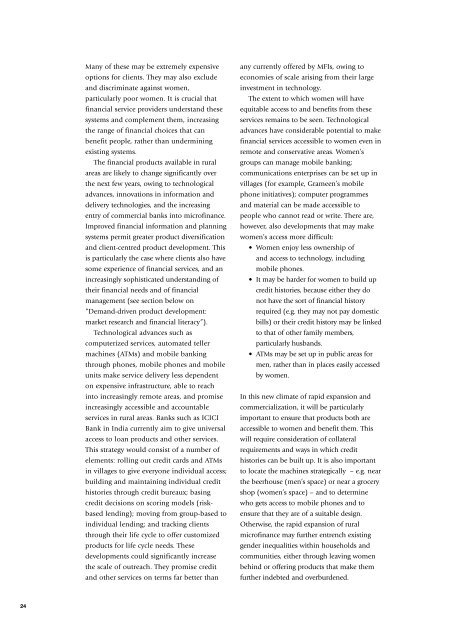Gender and rural microfinance: Reaching and empowering ... - IFAD
Gender and rural microfinance: Reaching and empowering ... - IFAD
Gender and rural microfinance: Reaching and empowering ... - IFAD
Create successful ePaper yourself
Turn your PDF publications into a flip-book with our unique Google optimized e-Paper software.
Many of these may be extremely expensive<br />
options for clients. They may also exclude<br />
<strong>and</strong> discriminate against women,<br />
particularly poor women. It is crucial that<br />
financial service providers underst<strong>and</strong> these<br />
systems <strong>and</strong> complement them, increasing<br />
the range of financial choices that can<br />
benefit people, rather than undermining<br />
existing systems.<br />
The financial products available in <strong>rural</strong><br />
areas are likely to change significantly over<br />
the next few years, owing to technological<br />
advances, innovations in information <strong>and</strong><br />
delivery technologies, <strong>and</strong> the increasing<br />
entry of commercial banks into <strong>microfinance</strong>.<br />
Improved financial information <strong>and</strong> planning<br />
systems permit greater product diversification<br />
<strong>and</strong> client-centred product development. This<br />
is particularly the case where clients also have<br />
some experience of financial services, <strong>and</strong> an<br />
increasingly sophisticated underst<strong>and</strong>ing of<br />
their financial needs <strong>and</strong> of financial<br />
management (see section below on<br />
“Dem<strong>and</strong>-driven product development:<br />
market research <strong>and</strong> financial literacy”).<br />
Technological advances such as<br />
computerized services, automated teller<br />
machines (ATMs) <strong>and</strong> mobile banking<br />
through phones, mobile phones <strong>and</strong> mobile<br />
units make service delivery less dependent<br />
on expensive infrastructure, able to reach<br />
into increasingly remote areas, <strong>and</strong> promise<br />
increasingly accessible <strong>and</strong> accountable<br />
services in <strong>rural</strong> areas. Banks such as ICICI<br />
Bank in India currently aim to give universal<br />
access to loan products <strong>and</strong> other services.<br />
This strategy would consist of a number of<br />
elements: rolling out credit cards <strong>and</strong> ATMs<br />
in villages to give everyone individual access;<br />
building <strong>and</strong> maintaining individual credit<br />
histories through credit bureaux; basing<br />
credit decisions on scoring models (riskbased<br />
lending); moving from group-based to<br />
individual lending; <strong>and</strong> tracking clients<br />
through their life cycle to offer customized<br />
products for life cycle needs. These<br />
developments could significantly increase<br />
the scale of outreach. They promise credit<br />
<strong>and</strong> other services on terms far better than<br />
any currently offered by MFIs, owing to<br />
economies of scale arising from their large<br />
investment in technology.<br />
The extent to which women will have<br />
equitable access to <strong>and</strong> benefits from these<br />
services remains to be seen. Technological<br />
advances have considerable potential to make<br />
financial services accessible to women even in<br />
remote <strong>and</strong> conservative areas. Women’s<br />
groups can manage mobile banking;<br />
communications enterprises can be set up in<br />
villages (for example, Grameen’s mobile<br />
phone initiatives); computer programmes<br />
<strong>and</strong> material can be made accessible to<br />
people who cannot read or write. There are,<br />
however, also developments that may make<br />
women’s access more difficult:<br />
• Women enjoy less ownership of<br />
<strong>and</strong> access to technology, including<br />
mobile phones.<br />
• It may be harder for women to build up<br />
credit histories, because either they do<br />
not have the sort of financial history<br />
required (e.g. they may not pay domestic<br />
bills) or their credit history may be linked<br />
to that of other family members,<br />
particularly husb<strong>and</strong>s.<br />
• ATMs may be set up in public areas for<br />
men, rather than in places easily accessed<br />
by women.<br />
In this new climate of rapid expansion <strong>and</strong><br />
commercialization, it will be particularly<br />
important to ensure that products both are<br />
accessible to women <strong>and</strong> benefit them. This<br />
will require consideration of collateral<br />
requirements <strong>and</strong> ways in which credit<br />
histories can be built up. It is also important<br />
to locate the machines strategically – e.g. near<br />
the beerhouse (men’s space) or near a grocery<br />
shop (women’s space) – <strong>and</strong> to determine<br />
who gets access to mobile phones <strong>and</strong> to<br />
ensure that they are of a suitable design.<br />
Otherwise, the rapid expansion of <strong>rural</strong><br />
<strong>microfinance</strong> may further entrench existing<br />
gender inequalities within households <strong>and</strong><br />
communities, either through leaving women<br />
behind or offering products that make them<br />
further indebted <strong>and</strong> overburdened.<br />
24

















